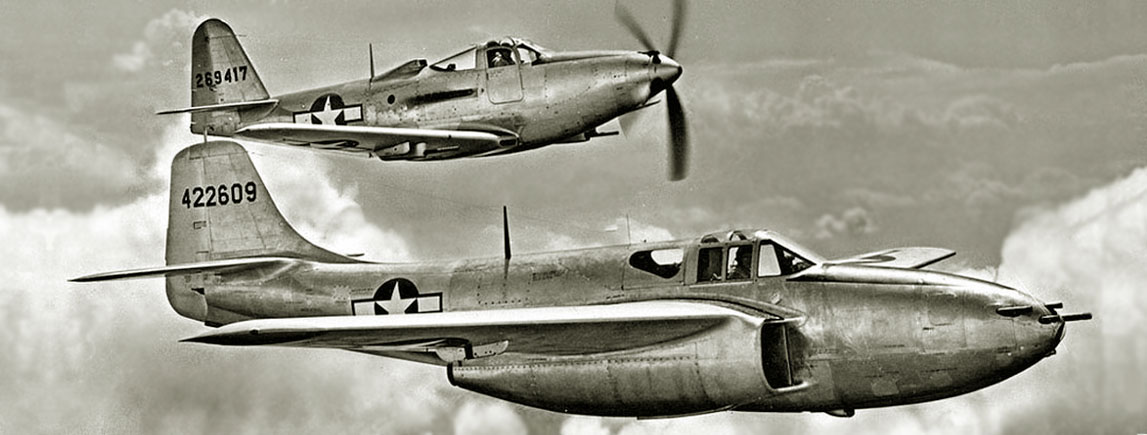
Aviation of World War II


 |
Aviation of World War II |


|
|
Soviet Union | Lend - Lease | Facts | Forum | Germany | Japan | R A F | U S A A F | Other | Photos |
|
|
P-59 "Airacomet"FighterBell
At the end of the 30s, the Americans experimented rather sluggishly with combined motokopressorny installations. The result was a unit based on a piston motor combined with an axial compressor. But he was never put on the plane, he weighed too much, was very bulky and consumed too much fuel. To make up for lost time, I had to turn to overseas experience. Help came from England in the form of blueprints, technical documentation and several prototypes of Wheatle's turbojet engine. Work on the design of an aircraft for these engines began immediately. Initially, the designation XP-59 belonged to another project of the Bell piston fighter - a two-boom aircraft with coaxial propellers. However, in December 1941, the US Air Force abandoned the construction of such an option, and the number "fifty-nine" subsequently passed to the company's first-born jet. The creation of aviation technology is always associated with mystery. In addition to the fact that for the new aircraft they left the index belonging to the earlier piston machine, all work was carried out in the strictest secrecy. The designers involved in the project were isolated from the rest of Bell's employees and housed not in the KB, but in a building on Elnwood Avenue in Buffalo (owned by Pierce Arrow). The construction of the prototype began in one of the institutions rented from Ford. It was from this building with barred windows and tinted glass that the first XP-59A was rolled out in September 1942. Construction The XP-59A had an all-metal structure with a trapezoidal wing and a tricycle landing gear with a nose wheel. The main struts were retracted by electric motors into the wing, and the nose - into the landing gear compartment in the bow. Two power spars in the wing went along the entire length, and the third reached half the span. The fuselage consisted of two parts. The front to the end of the cockpit consisted of frames, stringers and skin. The back was a monocoque with a working casing. All steering surfaces were covered with a canvas, and the flaps were extended from the electric motor. General Electric 1-A engines were located at the root of the wing on the sides of the fuselage and had unregulated oval air intakes. This placement of the turbojet engine ensured ease of operation and maintenance, which is very important when testing an experimental vehicle. In addition, stopping any of the engines in flight did not cause significant thrust asymmetry, since the nozzles were located close to the aircraft axis. With this arrangement, there was no need for long air ducts, which made the structure heavier and reduced traction. Air bleeding from the engines was used in the aircraft's high-altitude and anti-icing systems. The cockpit canopy was classic for fighters of those years - with side-folding glazing. The self-sealing fuel tanks were housed in the wing, and their total capacity was 1,097 liters. Of the small arms, it was planned to install two 37 mm M4 cannons in the nose with 44 rounds of ammunition per barrel (no weapons were installed on the first prototype). & nbsp; As already mentioned, the assembly of the first XP-59A was carried out in January 1942 in a building rented from Ford in Buffalo. Here the car received engines and on September 12, through a gap in the wall, it left its "cradle". That same night, disassembled and packed in large boxes, the XP-59A set off by rail to the secret Muroc base, located at the bottom of the dried-up Rogers Dry Lake in Southern California (now the famous US Air Force test center). The engines were working reliably. But soon the experienced motors showed their temper. The technicians were worn out with the GEI-A turbojet engine: very often, after their launch, flashes of flame flew out of the nozzle, and the engine did not produce the calculated thrust. Engine deficiencies such as unreliable fuel pump operation, overheating of the shaft bearings and rupture of turbine blades continued to be a major challenge in testing. |
|
|